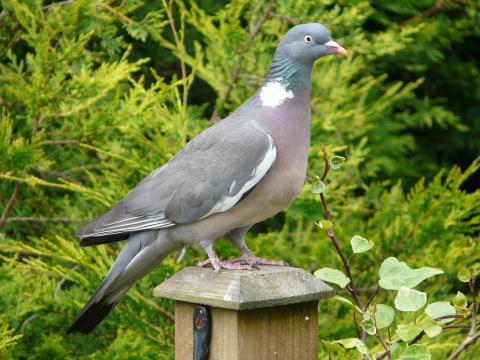Looking like a Wood Pigeon

I welcome Wood Pigeons to my little garden. They are big fat birds which gobble up the mess left by the sparrows. Without their vacuuming, discarded seeds from the feeders would germinate into weeds below.
Perhaps because of their size, and therefore desirability among predators (I once ate one myself at Sir Simon Towneley’s), they are more cautious than other birds and tend to fly away at the slightest hunch of danger. Several times I have popped outside only to cause a sudden flapping of wings and swift ascension. Last weekend, I stepped outside pursuing some chore only to see a Wood Pigeon which continued pecking at the ground. I was perhaps 6 feet away, but it made no effort to escape. Wood Pigeons have binocular vision, meaning that they can see ahead of them and on both sides at the same time. This is because their eyes are on the sides of their heads. Most birds are like this, but others, such as owls, have monocular vision like ours, and can only see forwards. So my feathered visitor, though able to look forward, was busy viewing his sides to see if danger approached. Had I been a cat, I should have caught it. I crept back inside and allowed my fat friend to conclude his meal.
Pigeon vision is superior to humans’ inasmuch as their eyes can cover more space as well as detect ultraviolet light. Yet this fellow’s sideway-glances were nearly his undoing. We humans were designed to only look forward. As Christians, we are urged to ‘Look unto Jesus, the author and finisher of our faith’ (Heb 12:2). Too many times, I fear we look sideways at our journey’s passing scenery and distractions. Worse, some like Lot’s wife look backwards, and pay a similar price.
Image: Uploaded by Snowmanradio
- Log in to post comments


 Sunday Worship 10.45am & 6.00pm
Sunday Worship 10.45am & 6.00pm